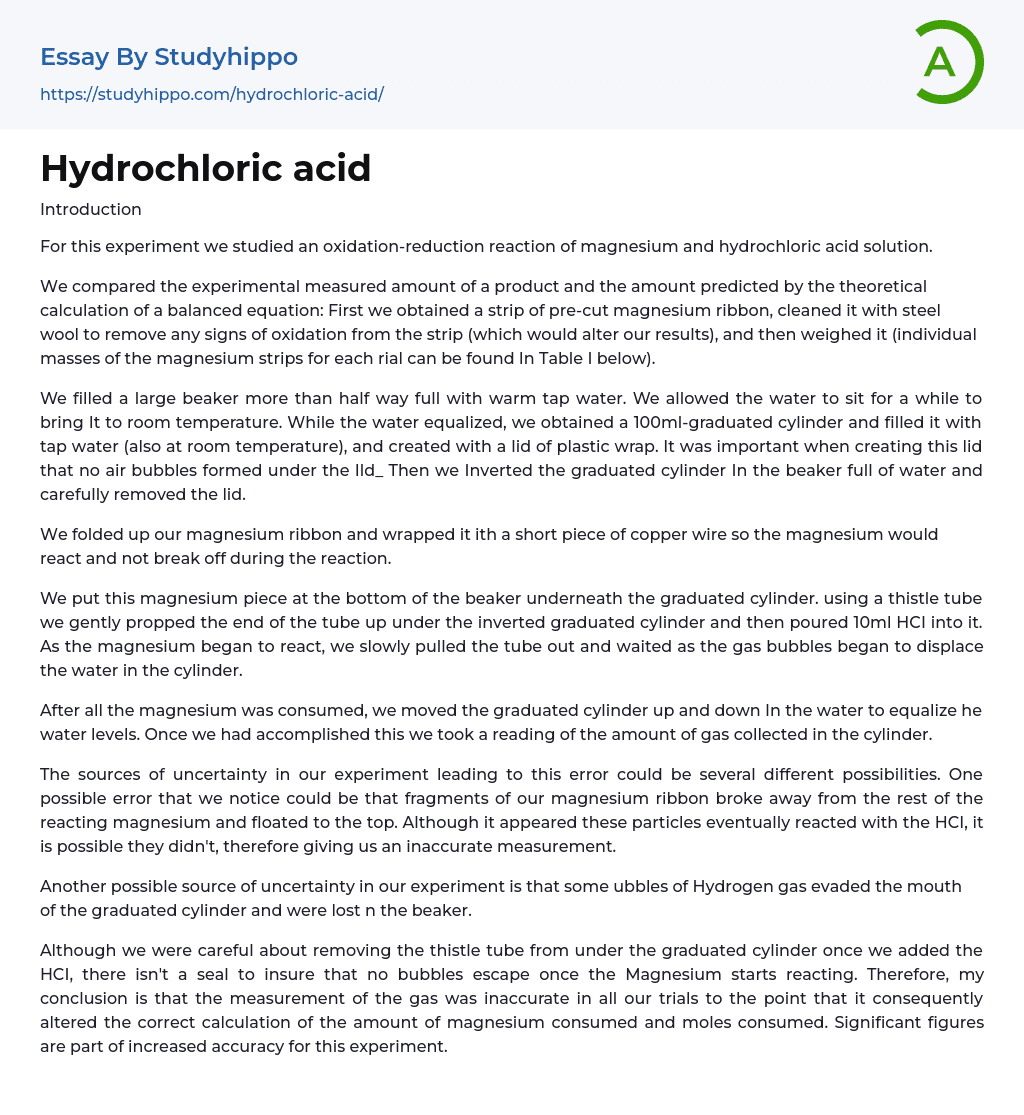Introduction
The purpose of this experiment was to examine the oxidation-reduction reaction of magnesium and a hydrochloric acid solution. We compared the amount of product measured in the experiment to the amount predicted by the balanced equation calculation. To start, we obtained a pre-cut strip of magnesium ribbon, cleaned it with steel wool to remove any oxidation, and then weighed it (individual masses of the magnesium strips for each trial can be found in Table I below). Subsequently, we filled a large beaker with warm tap water, filling it more than halfway.
We allowed the water to sit and reach room temperature. At the same time, we filled a 100ml-graduated cylinder with tap water, also at room temperature. To cover it, we used a lid made of plastic wrap, being careful to a
...void air bubbles underneath. The next step was to invert the graduated cylinder into a beaker filled with water, making sure to remove the lid cautiously. We prepared magnesium ribbon by wrapping it with a short piece of copper wire to prevent it from breaking off during the reaction. Placing the magnesium piece at the bottom of the beaker, under the graduated cylinder, we gently positioned one end of a thistle tube under the inverted graduated cylinder. Finally, we carefully poured 10ml of HCI into the thistle tube.
While the magnesium reacted, we extracted the tube gradually and observed the displacement of water by gas bubbles in the cylinder. After the entire magnesium was used up, we maneuvered the graduated cylinder in the water to even out the water levels. Subsequently, we recorded the quantity of gas accumulated i
the cylinder. There are various potential sources of uncertainty and error in our experiment. For instance, we detected that fragments of our reacting magnesium ribbon could have detached and risen to the surface.
Although there is a possibility that these particles did not react with the HCI, resulting in an inaccurate measurement, another source of uncertainty in our experiment is the escape of some bubbles of Hydrogen gas into the beaker. Despite being careful about removing the thistle tube from under the graduated cylinder after adding the HCI, there is no seal to prevent bubbles from escaping during the reaction of Magnesium. Therefore, the conclusion is that the measurement of gas in all trials was inaccurate, leading to an incorrect calculation of the amount of consumed magnesium and moles. It is important to note that significant figures contribute to increased accuracy in this experiment.The multiplication and division rule in this experiment states that when multiplying or dividing, the result must be reported with the same number of significant figures as the measurement with the fewest significant figures. Measurement is crucial in determining the required number of significant figures, and this must be applied consistently throughout all calculations. The tables above provide examples of the significant figures in each calculation.
- Organic Chemistry essays
- Acid essays
- Calcium essays
- Chemical Bond essays
- Chemical Reaction essays
- Chromatography essays
- Ethanol essays
- Hydrogen essays
- Periodic Table essays
- Titration essays
- Chemical reactions essays
- Osmosis essays
- Carbohydrate essays
- Carbon essays
- Ph essays
- Diffusion essays
- Copper essays
- Salt essays
- Concentration essays
- Sodium essays
- Distillation essays
- Amylase essays
- Magnesium essays
- Acid Rain essays
- Bottled Water essays
- Agriculture essays
- Albert einstein essays
- Animals essays
- Archaeology essays
- Bear essays
- Biology essays
- Birds essays
- Butterfly essays
- Cat essays
- Charles Darwin essays
- Chemistry essays
- Dinosaur essays
- Discovery essays
- Dolphin essays
- Elephant essays
- Eli Whitney essays
- Environmental Science essays
- Evolution essays
- Fish essays
- Genetics essays
- Horse essays
- Human Evolution essays
- Isaac Newton essays
- Journal essays
- Linguistics essays




